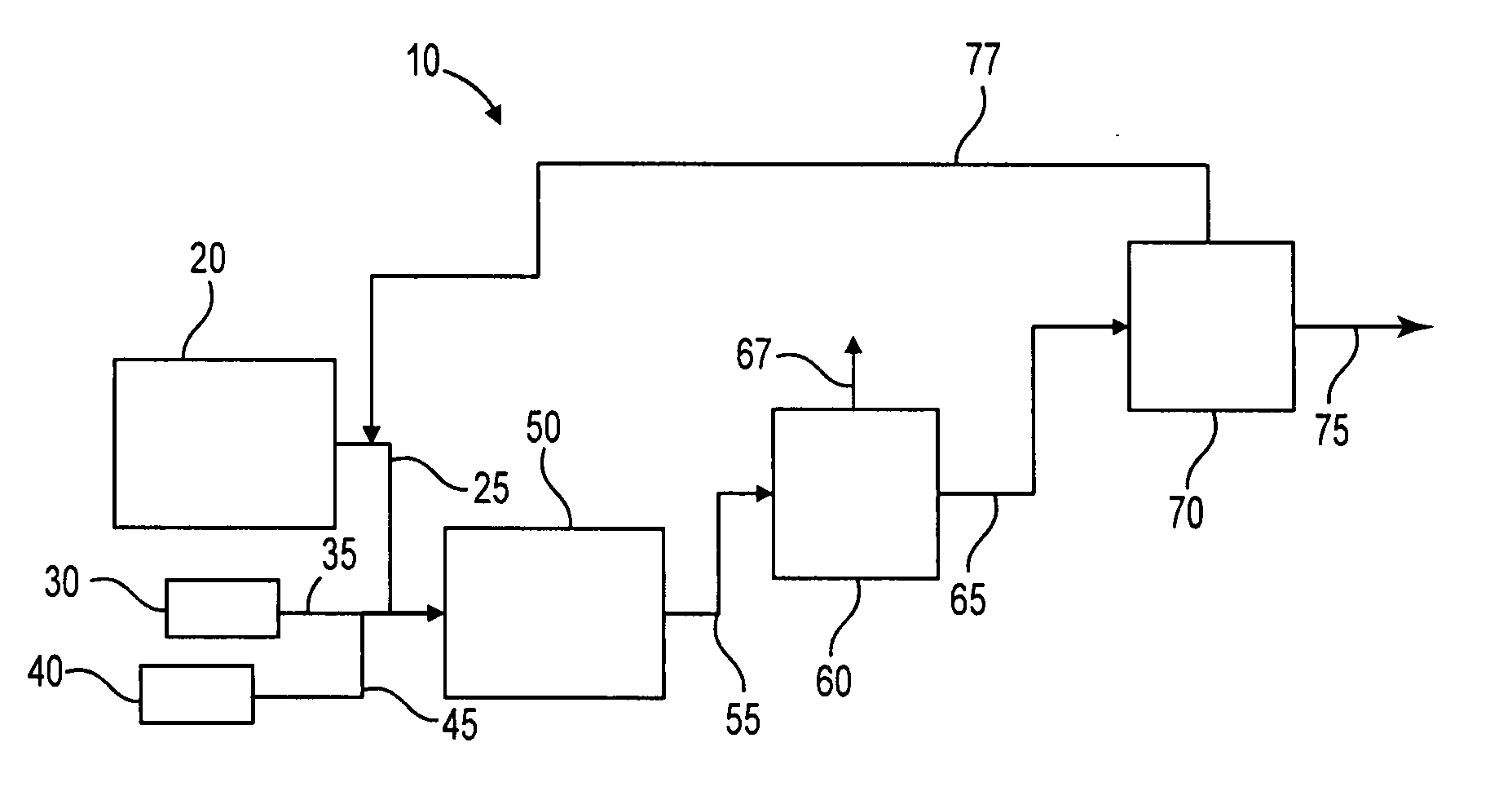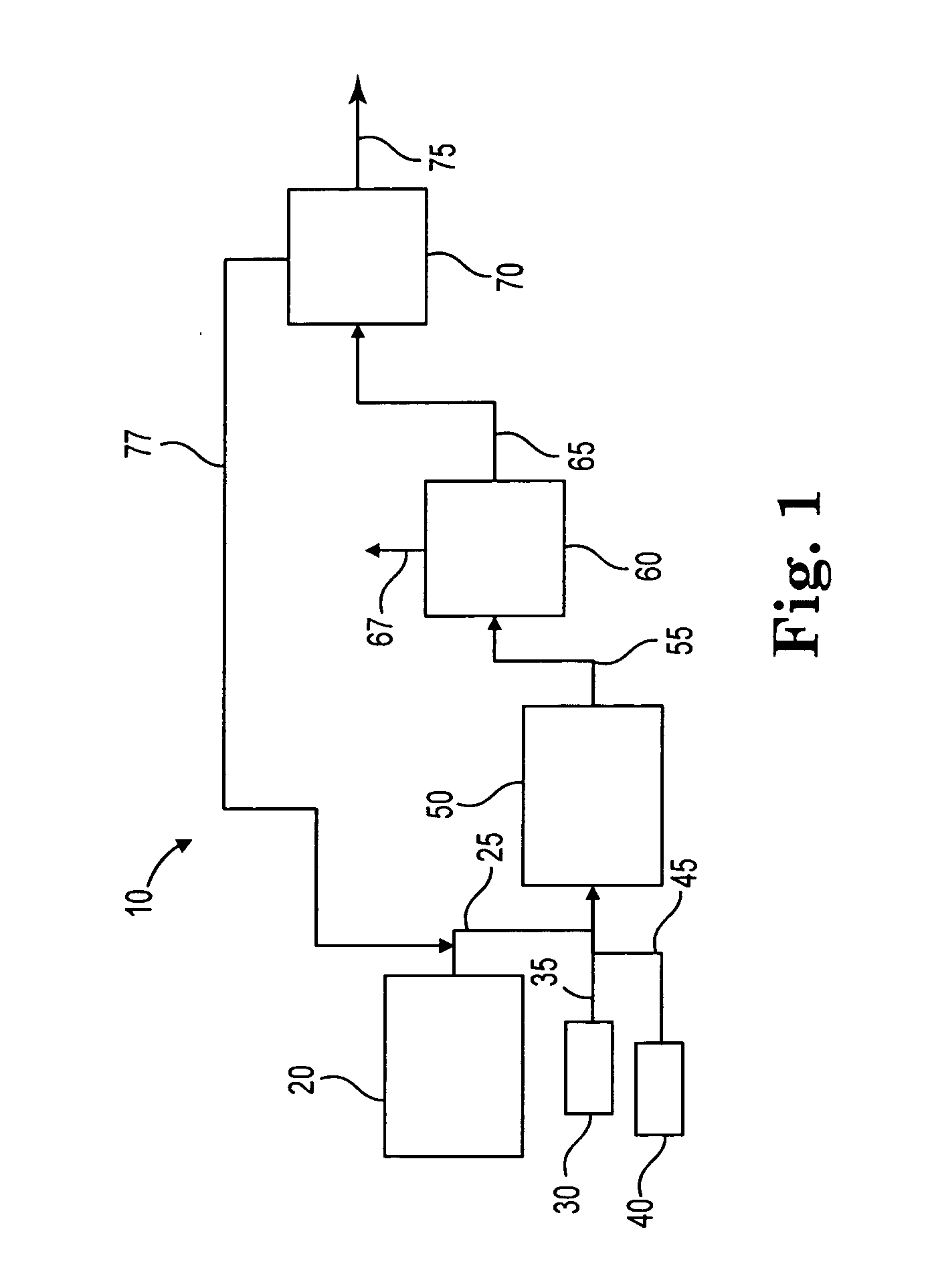Process to selectively manufacture diethylenetriamine (DETA) or other desirable ethylenamines via continuous transmination of ethylenediamine (EDA), and other ethyleneamines over a heterogeneous catalyst system
a technology of ethylenediamine and ethylenediamine, which is applied in the field of manufacturing one or more ethyleneamines, can solve the problems of limited selectivity of the transamination process and inefficiency of the process, and achieve the effect of minimizing the amount of less desirable ethyleneamines and maximizing the amount of desirable ethyleneamines produced
- Summary
- Abstract
- Description
- Claims
- Application Information
AI Technical Summary
Benefits of technology
Problems solved by technology
Method used
Image
Examples
example 1
[0040]Table 1 below shows the process is highly selective to DETA and TETA while keeping the level of cyclics (PIP, AEP, PEEDA) low. Also, the process can be operated at pressures from approximately 600 psia to 1000 psia at different EDA space velocities, hydrogen concentrations and temperatures while still maintaining good selectivity to acyclic products.
TABLE 1Reaction ConditionsT (° C.)156.4154.8138.4141.3144.8148.1148.5141.8142.6155.5156.0P (psia)61561581581581581581510151015101510H2, mole % in Feed0.96.05.85.06.25.50.91.76.02.20.00SV EDA, gmol / hr / kgcat27.227.814.714.314.415.315.910.125.29.627.0Feed (wt %)EDA99.98100.0099.9899.9899.9899.9899.9899.9899.9899.98100.00PIPDETAAEPI-TETAOTHER0.020.000.020.020.020.020.020.020.020.020.00Product composition (wt %)EDA68.8574.5589.5386.3382.1077.6569.6376.8492.6244.3069.00(no NH3)PIP4.142.300.340.530.981.624.061.660.1712.503.00DETA22.9720.529.6512.2815.5918.6422.6619.327.0329.0622.00AEP0.270.100.010.010.020.050.240.050.001.380.00I-TETA2.882...
example 2
[0041]Table 2 below shows the results of feeding EDA / DETA over the heterogeneous catalyst. A higher level of TETA is produced as compared to an EDA only feed while still maintaining low levels of cyclic materials.
TABLE 2Reaction ConditionsT (° C.)148.1148.5151.3153.6147.6149.1151.7154.0P (psia)815815815815815815815815H2, mole % in Feed4.24.44.34.34.84.84.64.3SV EDA, gmol / hr / kgcat13.513.413.613.512.412.612.713.2Feed (wt %)EDA96.0495.9295.9495.5891.0791.1491.0190.55PIPDETA3.924.044.014.388.848.788.799.36AEPI-TETAOTHER0.040.040.040.040.090.080.190.08Product composition (wt %)EDA72.2870.6465.4259.1268.2866.2561.6355.68(no NH3)PIP2.302.633.885.842.893.424.716.76DETA22.4123.3125.8428.0625.0025.8927.7029.40AEP0.100.120.200.380.160.190.290.49I-TETA2.582.893.955.363.223.664.726.11PEEDA0.020.030.050.110.030.040.070.15I-TEPA0.230.280.470.800.320.400.630.99OTHER0.040.060.130.260.070.100.180.34EDA conversion, %32.6034.3940.3647.1938.9141.4346.8753.56SelectivityDETA:PIP8.07.25.64.05.54.93.92.9TET...
example 3
[0042]Table 3 below shows the results of feeding EDA / PIP over the heterogeneous catalyst. As compared to the table above, it can be seen that at similar EDA conversions, the DETA / PIP ratio is improved (Note: the PIP in the feed is subtracted from the PIP produced in the product).
TABLE 3Reaction ConditionsT (° C.)146.1148.2150.8148.2152.1155.9P (psia)815815815815815815H2, mole % in Feed4.04.54.14.34.34.4SV EDA, gmol / hr / kgcat14.013.413.913.513.613.8Feed (wt %)EDA98.5498.5498.5596.4396.3796.37PIP1.451.461.453.573.633.63DETAAEPI-TETAOTHER0.000.000.000.000.000.00Product composition (wt %)EDA78.0373.4568.7171.6463.7653.93(no NH3)PIP2.873.604.615.847.6510.96DETA17.4720.4723.0820.0624.1527.35AEP0.030.070.120.070.180.50I-TETA1.452.163.042.143.655.76PEEDA0.010.010.030.020.050.16I-TEPA0.110.190.310.190.420.93OTHER0.010.030.070.030.110.34EDA conversion, %23.7428.9034.1829.1137.9748.82SelectivityDETA:PIP12.39.57.38.86.03.7TETA:PIP1.01.01.00.90.90.8(DETA + TETA) / PIP13.310.68.39.86.94.5NoteDETA:PI...
PUM
| Property | Measurement | Unit |
|---|---|---|
| wt. % | aaaaa | aaaaa |
| weight percent | aaaaa | aaaaa |
| weight percent | aaaaa | aaaaa |
Abstract
Description
Claims
Application Information
 Login to View More
Login to View More - R&D
- Intellectual Property
- Life Sciences
- Materials
- Tech Scout
- Unparalleled Data Quality
- Higher Quality Content
- 60% Fewer Hallucinations
Browse by: Latest US Patents, China's latest patents, Technical Efficacy Thesaurus, Application Domain, Technology Topic, Popular Technical Reports.
© 2025 PatSnap. All rights reserved.Legal|Privacy policy|Modern Slavery Act Transparency Statement|Sitemap|About US| Contact US: help@patsnap.com


